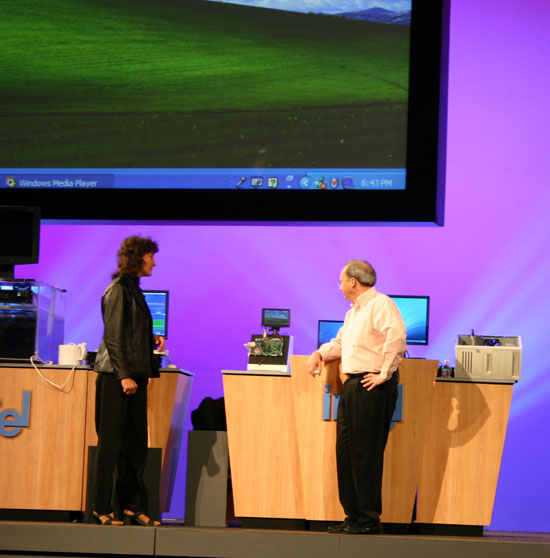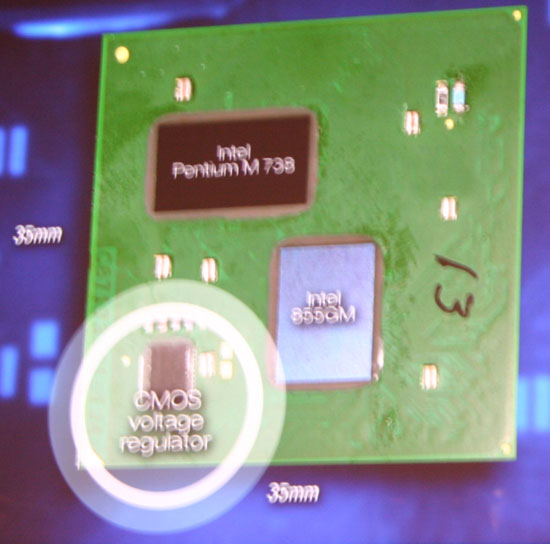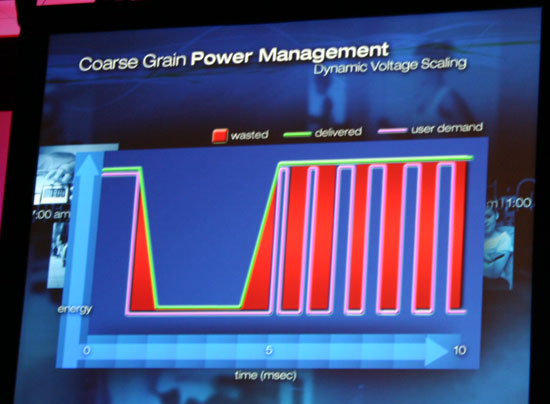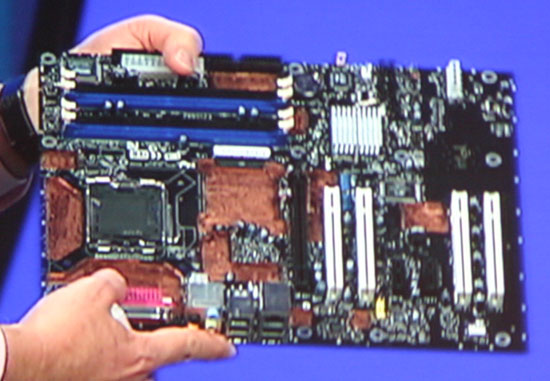Fall IDF 2005 - Day 3: Intel Demos On-Chip North Bridge & Voltage Regulator
by Anand Lal Shimpi on August 25, 2005 12:39 PM EST- Posted in
- Trade Shows
One of the biggest performance and technology advantages AMD has hold over Intel has been their on-die memory controller and North Bridge. Not only does AMD's on-die memory controller increase performance, but it saves overall system power as it can take advantage of the CPU's power management and advancements in microprocessor manufacturing technology.

Intel went in a slightly different direction today and showcased a research project of a Pentium M processor with an on-package GMCH, or North Bridge with integrated graphics.

Obviously this is different from doing an on-die north bridge, but you do get some significant performance benefits from moving the GMCH on chip. Note that the graphics core is also on the package, which is something we've heard AMD may be working on, but we were actually able to see a working demo from Intel today.

The integration went one step further, and included an on-package CMOS voltage regulator. The idea behind this integration step is that conventional voltage regulators on motherboards are relatively slow, they can't switch between voltage levels too quickly. They especially can't switch at the same rate as CPU demand changes:

Current Technology, the green line represents voltage and the blue spikes represent CPU demand
By moving to an on-package CMOS voltage regulator you not only simplify the motherboard, but you also get much faster voltage switching, meaning the voltage regulator can actually switch more frequently with CPU demand - resulting in something like the graph below.

CMOS based voltage regulators will enable much finer grained switching
Intel didn't commit to a timeframe of introducing this technology, but given that they had working silicon, we can expect that this project is something they truly wish to pursue.

A prototype motherboard using the technology. Note the lack of voltage regulators on the motherboard and the missing GMCH (North Bridge) chip.










36 Comments
View All Comments
TrogdorJW - Thursday, August 25, 2005 - link
On package generally means it will run at package speed (rather than bus speed). There would be a noticeable performance boost by going from a 400 MHz memory controller to a 2.0+ GHz memory controller. Hell, even Intel's GMA9x0 graphics could be pretty impressive if they were run at 2.0 GHz. Finally, putting everything on package can be seen as the first step towards moving on-chip. L2 cache with Pentium Pro, anyone?stevty2889 - Thursday, August 25, 2005 - link
I think the main reason for their doing this is for even more power savings on a laptop. Battery life can big a big concern for a lot of laptop users. I would never buy a laptop with intel graphics, but there are plenty of people who don't need more than that.brownba - Thursday, August 25, 2005 - link
regardless if there's any performance improvements,having the northbridge, graphics, and cpu on one package
will be great for embedded systems, laptops, etc.
Speedo - Thursday, August 25, 2005 - link
Well, closer is always better, from an electrical view. Also, you saw the graphs from that voltage regulator in action.// Frank
Larso - Friday, August 26, 2005 - link
Yeah pretty graphs, but far from the truth IMO. Look at the current technology power management, how can delivered power ramp up before user demand? Speculative power management? I think not.Speedo - Thursday, August 25, 2005 - link
There could be a way for the mobo makers to control the voltage regulator.Anyway, these improvements from Intel is interesting. I hope AMD has something similar going on...
// Frank